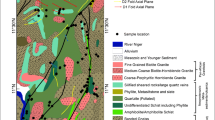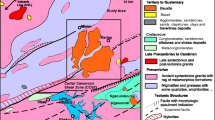Abstract
An approach is presented to establish a state-wide basis for geochemical background values from the available data of the Geological Survey of Bavaria. For this purpose, typical element background concentrations of rock units in Bavaria were statistically evaluated and presented in a lithogeochemical map derived from the geological map at a scale of 1:25,000. The elements comprise 39 geogenic main and trace elements (SiO2, Al2O3, Fe2O3, MnO, MgO, CaO, Na2O, K2O, TiO2, P2O5, Li, Be, Sc, V, Cr, Co, Ni, Cu, Zn, Ga, As, Rb, Sr, Y, Zr, Nb, Mo, Cd, Sn, Sb, Cs, Ba, La, Ce, Tl, Pb, Bi, Th, and U). The distributions of element concentrations in the lithogeochemical units follow closely lognormal patterns in a large majority of cases. Statistical parameters (10th, 25th, 50th, 75th, 90th percentiles) of investigated elements were determined using the cenfit function of the NADA package in the open-source R program. The investigation, based on 8,838 analysed samples, provided data for about 2/3 of the area of Bavaria. The lithogeochemical map with medians (50th percentiles) and background values (90th percentiles) of the investigated elements is available in a web map application. Thus, the regional geogenic background values of the investigated elements in Bavaria are publicly available for a large variety of applications, such as environmental issues and applied research questions.







Similar content being viewed by others
Availability of data and materials
Additional material and data of the study not published in this paper are available from the corresponding author upon reasonable request.
Code availability
Not applicable.
References
Demitriades A, Smith DB, Wang X (2018) General concepts of geochemical mapping at global, regional, and local scales for mineral exploration and environmental purposes. Geochimica Brasiliensis 32/2:136–179. https://doi.org/10.21715/GB2358-2812.2018322136
De Vos WDE, Tarvainen T (2006) Geochemical Atlas of Europe. Part 2: Interpretation of Geochemical Maps, Additional Tables, Figures, Maps and Related Publications, Geological Survey of Finland, Espoo, 690 p. http://weppi.gtk.fi/publ/foregsatlas/part2.php Accessed 20 Jan 2022
Geuß U, Hangen E, Martin W (2011) Hintergrundwerte von anorganischen und organischen Schadstoffen in Böden Bayerns. UmweltSpezial, Bayerisches Landesamt für Umwelt, Augsburg, p 59. https://www.lfu.bayern.de/boden/hintergrundwerte/doc/hintergrundwert_umweltspezial.pdf Accessed 20 Jan 2022
Helsel DR (2012) Statistics for censored environmental data using Minitab and R, 2nd edn. Wiley, New York, p 344
Lee L (2017) Package ‚NADA‘ - Nondetects and Data Analysis for Environmental Data. 64 p. https://cran.r-project.org/web/packages/NADA/NADA.pdf. Accessed 20 Jan 2022
Lepeltier C (1969) A simplified statistical treatment of geochemical data by graphical representation. Econ Geol 64:538–550 (Lancaster, PA)
Licht OA (2020) Geochemical background—what a complex meaning has such a simple expression! Geochimica Brasiliensis 34/2:161–175. https://doi.org/10.21715/GB2358-2812.2020342161
Linhardt E, Zarbok P (2005) Geochemischer Atlas natürlicher Haupt-, Neben- und Spurenelemente der Gesteine Bayerns. Fachbericht, 24:188 p, Bayerisches Geologisches Landesamt, München. https://www.bestellen.bayern.de/shoplink/92024.htm Accessed 20 Jan 2022
Reimann C, de Caritat P (2017) Establishing geochemical background variation and threshold values for 59 elements in Australian surface soil. Sci Total Environ 578:633–648. https://doi.org/10.1016/j.scitotenv.2016.11.010
Salminen R, Batista MJ, Bidovec M, Demetriades A, De Vivo B, De Vos W, Duris M, Gilucis A, Gregorauskiene V, Halamic J, Heitzmann P, Lima A, Jordan G, Klaver G, Klein P, Lis J, Locutura J, Marsina K, Mazreku A, O'Connor PJ, Olsson SÅ, Ottesen R-T, Petersell V, Plant JA, Reeder S, Salpeteur I, Sandström H, Siewers U, Steenfelt A, Tarvainen T (2005) Geochemical Atlas of Europe Part 1: Background Information, Methodology and Maps. Geological Survey of Finland. http://weppi.gtk.fi/publ/foregsatlas/index.php Accessed 20 Jan 2022
Sinclair AJ (1976) Applications of probability graphs in mineral exploration. The Association of Exploration Geochemists, Special Volume 4:95 p, Richmond Printers Ltd, Richmond
Tammen A, Jung D, Wagner B, Wittenbecher M (2020) Lithogeochemische Hinter-grundwerte der Gesteine Bayerns. UmweltSpezial, Bayerisches Landesamt für Umwelt, Augsburg, 173 p. https://www.bestellen.bayern.de/shoplink/lfu_bod_00172.htm Accessed 20 Jan 2022
Wagner B, Walter T, Himmelsbach T, Clos P, Beer A, Budziak D, Dreher T, Fritsche H-G, Hübschmann M, Marczinek S, Peters A, Poeser H, Schuster H, Steinel A, Wagner F, Wirsing G (2011) Hydrogeochemische Hintergrundwerte der Grundwässer Deutschlands als Web Map Service. Grundwasser 16(3):155–162. https://doi.org/10.1007/s00767-011-0161-1 (Springer, Berlin)
Walter T, Beer A, Brose D, Budziak D, Clos P, Dreher T, Fritsche H-G, Hübschmann M, Marczinek S, Peters A, Poeser H, Schuster H, Wagner B, Wagner F, Wirsing G, Wolter R (2012) Determining natural background values with probability plots. Groundw Qual Sustain IAH Sel Pap Hydrogeol 26:331–341 (CRC Press)
Zgłobicki W, Lata L, Plak A, Reszka M (2011) Geochemical and statistical approach to evaluate background concentrations of Cd, Cu, Pb and Zn (case study: Eastern Poland). Environ Earth Sci 62:347–355. https://doi.org/10.1007/s12665-010-0529-z
Acknowledgements
This study was carried out as part of the project “Soil Atlas Bavaria“. The authors gratefully acknowledge funding of the project by the European Regional Development Fund (ERDF) in the funding period 2014–2020 and by the Bavarian State Ministry for the Environment and Consumer Protection. The authors thank the anonymous reviewers for their valuable suggestions and comments that helped improve the paper.
Funding
This study was jointly funded by the Bavarian State Ministry for the Environment and Consumer Protection and by the European Regional Development Fund (ERDF) in the funding period 2014–2020.
Author information
Authors and Affiliations
Contributions
BW: conceptualization; methodology; supervision; validation; writing—original draft; and writing—review and editing. AT: validation; methodology; data curation; formal analysis; investigation; software; visualization; and writing—original draft. DJ: supervision; validation; and writing—original draft.
Corresponding author
Ethics declarations
Conflict of interest
The authors declare that they have no conflict of interest.
Additional information
Publisher's Note
Springer Nature remains neutral with regard to jurisdictional claims in published maps and institutional affiliations.
Rights and permissions
About this article
Cite this article
Wagner, B., Tammen, A. & Jung, D. Determining the lithogeochemical background concentrations of 39 elements in Bavarian rocks. Environ Earth Sci 81, 207 (2022). https://doi.org/10.1007/s12665-022-10334-8
Received:
Accepted:
Published:
DOI: https://doi.org/10.1007/s12665-022-10334-8




